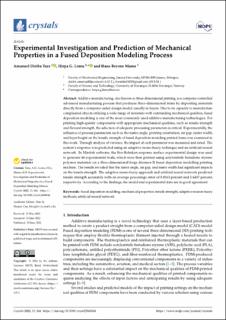| dc.contributor.author | Tura, Amanuel | |
| dc.contributor.author | Lemu, Hirpa Gelgele | |
| dc.contributor.author | Mamo, Hanna | |
| dc.date.accessioned | 2022-08-18T08:02:12Z | |
| dc.date.available | 2022-08-18T08:02:12Z | |
| dc.date.created | 2022-08-17T14:12:42Z | |
| dc.date.issued | 2022-06-15 | |
| dc.identifier.citation | Tura, A. D., Lemu, H. G., & Mamo, H. B. (2022). Experimental Investigation and Prediction of Mechanical Properties in a Fused Deposition Modeling Process. Crystals, 12(6), 844. | |
| dc.identifier.issn | 2073-4352 | |
| dc.identifier.uri | https://hdl.handle.net/11250/3012496 | |
| dc.description.abstract | Additive manufacturing, also known as three-dimensional printing, is a computer-controlled advanced manufacturing process that produces three-dimensional items by depositing materials directly from a computer-aided design model, usually in layers. Due to its capacity to manufacture complicated objects utilizing a wide range of materials with outstanding mechanical qualities, fused deposition modeling is one of the most commonly used additive manufacturing technologies. For printing high-quality components with appropriate mechanical qualities, such as tensile strength and flexural strength, the selection of adequate processing parameters is critical. Experimentally, the influence of process parameters such as the raster angle, printing orientation, air gap, raster width, and layer height on the tensile strength of fused deposition modeling printed items was examined in this work. Through analysis of variance, the impact of each parameter was measured and rated. The system’s response was predicted using an adaptive neuro-fuzzy technique and an artificial neural network. In Minitab software, the Box-Behnken response surface experimental design was used to generate 46 experimental trials, which were then printed using acrylonitrile butadiene styrene polymer materials on a three-dimensional forge dreamer II fused deposition modelling printing machine. The results revealed that the raster angle, air gap, and raster width had significant impacts on the tensile strength. The adaptive neuro-fuzzy approach and artificial neural network predicted tensile strength accurately with an average percentage error of 0.0163 percent and 1.6437 percent, respectively. According to the findings, the model and experimental data are in good agreement. | en_US |
| dc.language.iso | eng | en_US |
| dc.publisher | MDPI | en_US |
| dc.rights | Navngivelse 4.0 Internasjonal | * |
| dc.rights.uri | http://creativecommons.org/licenses/by/4.0/deed.no | * |
| dc.subject | fused deposition modeling | en_US |
| dc.subject | mechanical properties | en_US |
| dc.subject | tensile strength | en_US |
| dc.subject | adaptive neuron-fuzzy methods | en_US |
| dc.subject | artificial neural network | en_US |
| dc.title | Experimental Investigation and Prediction of Mechanical Properties in a Fused Deposition Modeling Process | en_US |
| dc.type | Journal article | en_US |
| dc.type | Peer reviewed | en_US |
| dc.description.version | publishedVersion | en_US |
| dc.rights.holder | Copyright: © 2022 by the authors | en_US |
| dc.subject.nsi | VDP::Technology: 500::Mechanical engineering: 570 | en_US |
| dc.source.pagenumber | 1-16 | en_US |
| dc.source.volume | 12 | en_US |
| dc.source.journal | Crystals | en_US |
| dc.source.issue | 6 | en_US |
| dc.identifier.doi | https://doi.org/10.3390/cryst12060844 | |
| dc.identifier.cristin | 2043857 | |
| cristin.ispublished | true | |
| cristin.fulltext | original | |
| cristin.qualitycode | 1 | |

